Invasive Species: Nandina domestica, Sacred Bamboo
Sacred bamboo invades forests throughout the Southeastern United States. It is a small, erect shrub that grows up to 8 ft (2.4 m) tall. Leaves are alternate, large, and bi- or tri-pinnately compound, with small leaflets that are 1 to 2 in. (2.5 to 5.1 cm) long. Flowering occurs in the spring, when small, white flowers develop in large panicles at the ends of the stems. Flowers have three to six reflexed petals. Fruits are green berries that mature to bright red. The older stems have bark with long, linear furrows. The overlapping leaf sheaths give the main stem the appearance of bamboo, hence the name. Sacred bamboo is shade tolerant, allowing it to invade forest edges and interiors. It is native to eastern Asia and India and was introduced in North America in the early 1800s. It has been planted widely as an ornamental plant and often escapes from old plantings.
What are invasive species, and why should we be concerned about them?
Taxonomy: Scientific and Common Names for This Species
Ranunculales > Berberidaceae > Nandina domestica Thunb.
Synonym(s): heavenly bamboo, nanten
Nandina domestica – USDA PLANTS Profile
Distribution Maps
sacred bamboo – The reported distribution of this invasive species across the United States (Source: Invasive Plant Atlas of the United States)
Up-to-the-minute distribution maps and why they are important
Reporting This Invasive Species
What is the best way to report the occurrence of an invasive species?
How to report an invasive species sighting to EDDMapS – Early Detection & Distribution Mapping System
EDDMapS – Report an invasive species to EDDMapS.
County Extension Offices – Find your county Extension office on this map provided by USDA.
How to Identify
This invasive species can be identified by looking for the characteristics described in the paragraphs that follow.
Shrub
Sacred bamboo is a small, erect shrub that grows up to 8 ft (2.4 m) tall.
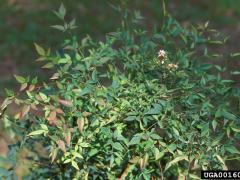 |
 |
| James H. Miller, USDA Forest Service, bugwood.org | James H. Miller, USDA Forest Service, bugwood.org |
Foliage
Leaves are alternate, large, and bi- or tri-pinnately compound, with small leaflets that are 1 to 2 in. (2.5 to 5.1 cm) long.
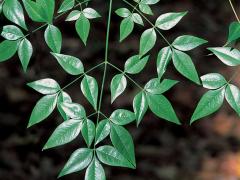 |
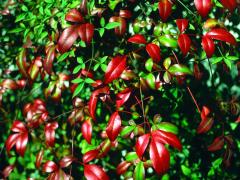 |
| James H. Miller, USDA Forest Service, bugwood.org | Ken A. Langeland, University of Florida, bugwood.org |
Flower
Flowering occurs in the spring, when small, white flowers develop in large panicles at the ends of the stems. Flowers have three to six reflexed petals.
 |
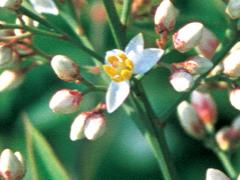 |
| James H. Miller, USDA Forest Service, bugwood.org | James H. Miller, USDA Forest Service, bugwood.org |
Fruit
Fruits are green berries that mature to bright red.
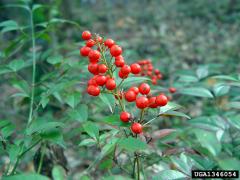 |
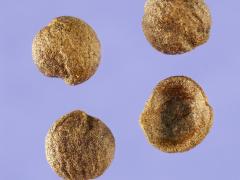 |
| Chris Evans, River to River CISMA, bugwood.org | Steve Hurst, USDA NRCS PLANTS Database, bugwood.org |
Native Species That Resemble Sacred Bamboo
– Images at invasive.org
| bugwood.org | bugwood.org |
– Images at invasive.org
| bugwood.org | bugwood.org |
Additional Images for Sacred Bamboo
sacred bamboo – Images at invasive.org
Learning Resources for Sacred Bamboo
Additional Information, Biology, Control and Management Resources
Control and management recommendations vary according to individual circumstances. Location, habitat, weather, and a variety of other conditions are factors that help determine the best treatment choice. To find the safest and most effective treatment for your situation, consult your state’s land-grant institution. If you will use chemicals as part of the control process, always refer to the product label.
United States Land-Grant University System – Find your Land-Grant University’s College of Agriculture, University Cooperative Extension Service, or other related partner on this map provided by USDA.
A Management Guide for Invasive Plants of Southern Forests – USDA Forest Service
A Field Guide for the Identification of Invasive Plants in Southern Forests – USDA Forest Service
Element Stewardship Abstract – Florida Exotic Pest Plant Council (FLEPPC)
Center for Aquatic and Invasive Plants – University of Florida’s Institute of Food and Agricultural Sciences (IFAS)
Weed of the Week – USDA Forest Service
